World of Coffee beans | World of defective Coffee beans
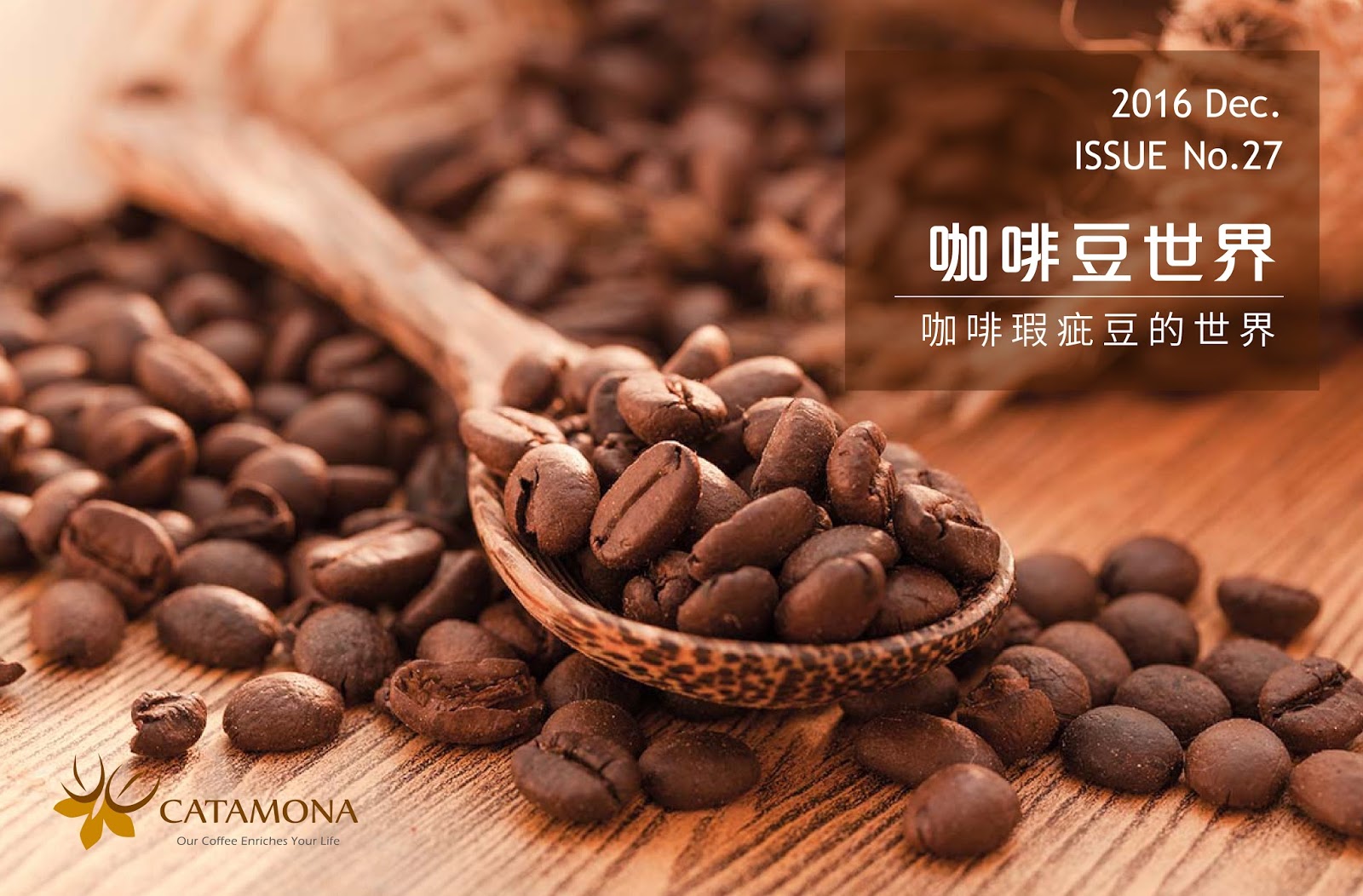
For professional baristas, please follow the coffee workshop (Wechat official account cafe_style)
To show you the world of defective coffee beans.
Coffee growing environment
The difference in the appearance of coffee beans comes from different growth environments. The growth zones of coffee are usually Tropic of Cancer and Tropic of Cancer and tropical areas near the equator. Unique coffee varieties are planted in special growth areas, and there are many kinds of coffee beans and growing environment. In the books on boutique coffee beans, it is mentioned that the newly improved varieties derived from Arabica, such as Typica, Bourbon traditional varieties and Caturra, Kenyan Ruirull, are mainly produced at higher elevations between 600m and 1000m, which is different from the evaluation of Canophora/Robusta varieties produced at lower elevations. [1] due to environmental differences, there are many differences in the appearance of coffee beans, ranging from yellow-green to dark green or even to brass.
There are three main varieties of coffee beans in business, and the most widely cultivated is Arabica, which is the most important and best quality coffee bean. Arabica beans grow in the high mountains of 500m--2000m above sea level. They are neither resistant to high temperature nor rain, and their cost is higher than other coffee beans, but their flavor is really good. If we want to write an adjective for Arabica beans, they should belong to the "princess" type of beans.
Coffee planting method
To cultivate a perfect bean needs to mention the growing environment, of course, the planting method is also very important. Coffee trees are planted under shady trees to avoid the scorching sun. This planting method is called "Yu Ying style". The United States Department of Agriculture has conducted a study that the Yu Yin planting area can stabilize nitrogen concentration, prevent soil erosion, reduce drought and strong winds, and so on. On the other hand, there is another kind of modern planting, called "shading", which can grow in the hot sun without shade after variety improvement, so the distance between coffee trees can be shortened and the yield can be increased.
Defective beans in coffee beans
Without screening, throw raw beans into the roasting, baked beans, no matter how good technology can not make delicious coffee. Because coffee beans are often mixed with impurities and bad beans, and bad beans are called "defective beans". So this little knowledge is very important, but how many kinds of defective beans are there? The types of raw bean defects listed below are described:
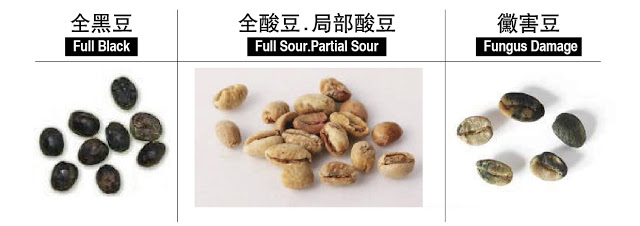
● all-black bean (Full Black)
◎ features: whole or local raw beans appear black and opaque.
The reason for the formation of ◎: blackening is caused by excessive fermentation, such as fermentation or smelly, dusty odor, mildew and decay.
● whole sour beans. Local sour bean (Full Sour.Partial Sour)
◎ characteristics: beans are considered sour beans when they are yellowish brown or reddish brown.
The reason for the formation of ◎: sour beans are contaminated by bacteria in the process of harvest and treatment.
● mildew damage bean (Fungus Damage)
◎ characteristics: yellow-brown and reddish-brown spots in the early stage of mildew-damaged beans indicated that they were eroded by irritant spores.
The reason for the formation of ◎: mildew damage to beans is usually due to the presence of mold spores on beans, which will cause mold to grow and infect beans when stored at a certain temperature and humidity after harvest.
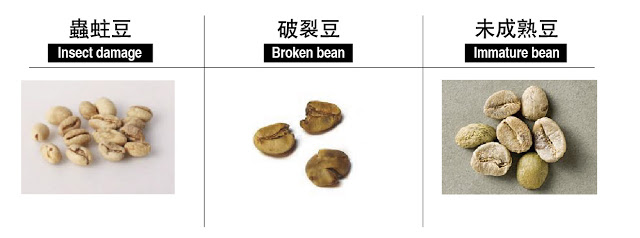
● borer bean (Insect damage)
◎ characteristics: diameter 0.3-1. Smm's small black hole is usually on the inside of the coffee bean.
The reason for the formation of ◎: in coffee agriculture, insect pests are the most serious, while the fruit is still on the tree, the worm has already drilled into the fruit to breed.
● broken bean (Broken bean)
◎ characteristics: broken beans usually have a dark red area due to oxidation.
Cause of ◎ formation: broken beans usually break when dealing with pulp or dry processing, incorrectly correcting the machine and excessive friction or extrusion.
● immature bean (Immature bean)
◎ characteristics: immature beans can be distinguished by the pale and yellowish green skin or the white spots of the skin.
There are many reasons for the formation of ◎: there are many reasons for not fully maturing, improper harvesting of immature fruits and berries that are too late to mature at higher elevations.
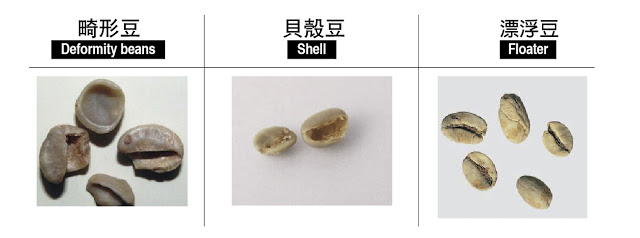
● deformed bean (Deformity beans)
◎ features: abnormal shape, off-center incision slightly enlarged.
The cause of ◎ formation: growth defects, physiological factors.
● shell (Shell)
◎ features: shell beans are separated and deformed from the inside or outside at the same time.
The reason for the formation of ◎ is mainly due to genetic variation.
● floating bean (Floater)
◎ features: the appearance of floating beans is particularly white or faded, while raw beans will have spots.
Cause of ◎ formation: for processing, this disadvantage is caused by improper storage or drying, which usually leads to discoloration or low bean density.

After reading all kinds of broken defective beans above, you should know how important the process of picking beans is if you want to have a good cup of coffee. A cup of coffee that does not pick beans will certainly have a great impact on the overall quality, but the flavor of the coffee may be slightly defective, or it may be some very unpleasant taste, the so-called "a grain of mouse shit spoils a pot of porridge". It's really appropriate to put it here. In strict grading and exquisite roasting, we know that a cup of coffee is the key to a good cup of coffee in the process of selecting and baking beans.
Reference books:
Note 1: explore boutique coffee; page 94; Zhuo Weimin / book; 2009; taste book
Important Notice :
前街咖啡 FrontStreet Coffee has moved to new addredd:
FrontStreet Coffee Address: 315,Donghua East Road,GuangZhou
Tel:020 38364473
- Prev
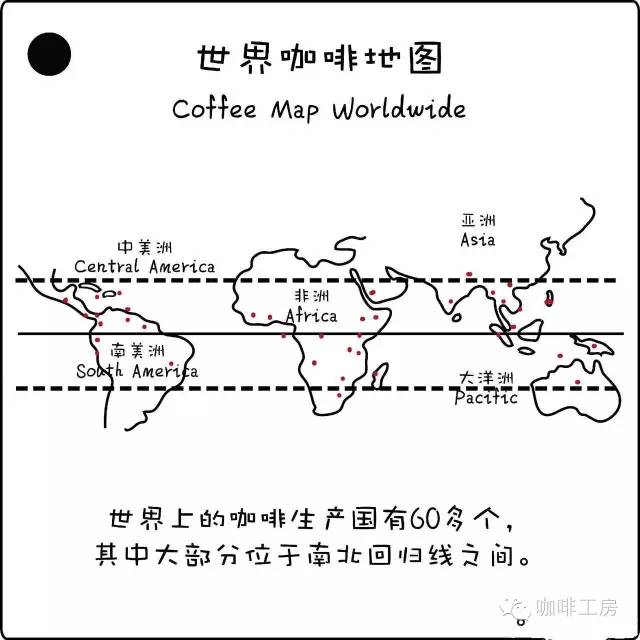
Popular science | introduction to the types and tastes of individual coffee in the cafe
Professional baristas follow the Coffee Workshop (official Wechat account cafe_style) now walking into a coffee shop, you can see not only cappuccino, latte, mocha and other coffee, but also coffee from different place names of different countries. People who are in initial contact with boutique coffee know something about it, and it is easy to order. So how do you learn from these eyes if you haven't come into contact with boutique coffee?
- Next

At these moments, you need a cup of coffee.
Professional baristas Please follow the Coffee Workshop (official Wechat account cafe_style) someone told the coffee maker that drinking coffee is an addictive thing, because you will enjoy the feeling it makes you more and more, which can not be replaced by other drinks. So is there a moment when you think you need a cup of coffee the most? Today, Mr. Coffee will make a list of the people who want to drink coffee most.
Related
- Beginners will see the "Coffee pull flower" guide!
- What is the difference between ice blog purified milk and ordinary milk coffee?
- Why is the Philippines the largest producer of crops in Liberia?
- For coffee extraction, should the fine powder be retained?
- How does extracted espresso fill pressed powder? How much strength does it take to press the powder?
- How to make jasmine cold extract coffee? Is the jasmine + latte good?
- Will this little toy really make the coffee taste better? How does Lily Drip affect coffee extraction?
- Will the action of slapping the filter cup also affect coffee extraction?
- What's the difference between powder-to-water ratio and powder-to-liquid ratio?
- What is the Ethiopian local species? What does it have to do with Heirloom native species?

